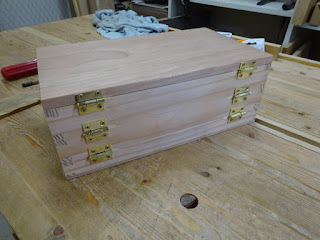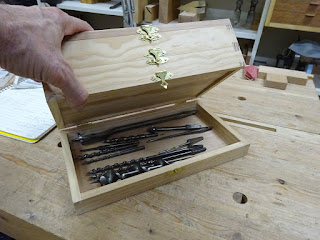Recently on vacation in the high country of Colorado, we were treated to many large stands of aspen trees (populus tremuloides).
 |
| A stand of aspen showing off the white bark |
I'm guessing the species name "tremuloides" has to do with the way the leaves quiver or quake in the wind. In fact, some common names for aspen are "quaking aspen" or "trembling aspen".
 |
| Closer pic of the bark. Note the lack of lower branches |
Aspen trees often shed their lower branches as they grow taller. Stands of aspen are typically fairly dense and there is competition for light. The lower branches don't help much in that regard.
 |
A few aspen trees at the edge of a stand. The one on the right has branches
all the way down it's trunk, but only on the side away from the other trees. |
When branches are shed, it leaves a black scar on the trunk. These are sometimes called "eyes" because of the occasional resemblance.
 |
| A thick group of aspens. Note the black scars. |
 |
| Close-up of the tree on the left in the previous picture, showing the eyes |
These trees live in a pretty tough climate, which can have interesting consequences on their shape. Look at this small tree.
 |
| Very gnarly trunk. Some full grown trees also had gnarled trunks. |
Even with the tough climate, most of the trees were fairly straight. The largest one I came across was about 18" in diameter. And, of course, I had to wonder about its use as a furniture wood. I'd never heard of aspen being used in furniture, so I thought I'd do a little research. I'll get to that later.
The leaves of an aspen are fairly small, just a couple of inches long and wide.
 |
| Top side of an aspen leaf. Note the interesting vein structure. |
 |
| Bottom of same leaf, lighter color and very interesting pattern |
 |
| Close-up of lower portion of above photo |
I just love seeing these intricate patterns in nature. Very cool. Organized randomness.
Aspens have the ability to sprout from the roots of an existing tree. In fact, a group of aspen trees may all be related - growing from the roots of the "parent" tree. After a forest fire, aspens can start up again because the root system below ground is still intact. It has been said that all the aspens in a grove can be part of the same organism. That is, their roots are all inter-connected. I read that there is a grove in Utah that is considered one of the largest living things on Earth.
OK, on to woodworking stuff. Though I've never seen it in person (pictures of the long grain and end grain are
here), aspen wood seems very similar to what we call poplar in texture and hardness (it's very soft for a "hardwood"). Here's the tough part - what we know of as poplar (or tulip poplar, or yellow poplar - the one with the greenish heartwood) is actually not a true poplar. The true poplars are from the genus populus, which includes the aspen, white poplar and cottonwoods. What we know in America as "poplar" (liriodendron tulipifera), the one that contains the greenish heartwood, is actually in the magnolia family and is not a true poplar.
From what I've found online, aspen is often used as a pulp wood for paper manufacture and its chips are one of the most used in OSB. However it can be used for furniture, but because of its softness it will bruise easily.
Sources for the information presented above include:

























